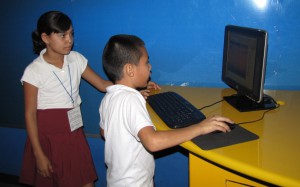Why do we need technology in schools if it doesn’t improve quality?
- Gabriel Sánchez Zinny
- 31 octubre, 2015
- Opinión
Some of the never-before-seen phenomena of today— rapidly expanding connectivity, mobile entrepreneurship, the breakdown of traditional corporate relationships, the global skills gap—have left students facing unexpected pressures, as well as unimagined opportunities. It’s clear that the use of technology is now key for everyone hoping to join the labor force. As Average is Over author Tyler Cowen claims, “workers more and more will come to be classified into two categories. The key question will be: ‘are you good at working with intelligent machines or not? Are your skills a complement to the skills of the computer, or is the computer doing better without you?’”
 In a world where more than 70 percent of jobs require the use of some kind of technology, where the shared economy and knowledge society are expanding every day, students of all ages need to develop skills to work with machines. However, is new technology impacting the way schools educate? Is it having any impact on quality and access? The most recent OECD-PISA report provides some answers about this, but raises more questions. The report found no appreciable improvements in student achievement in reading, mathematics, or science in the countries that had invested heavily in information and communication technologies (ICT) for Education.
In a world where more than 70 percent of jobs require the use of some kind of technology, where the shared economy and knowledge society are expanding every day, students of all ages need to develop skills to work with machines. However, is new technology impacting the way schools educate? Is it having any impact on quality and access? The most recent OECD-PISA report provides some answers about this, but raises more questions. The report found no appreciable improvements in student achievement in reading, mathematics, or science in the countries that had invested heavily in information and communication technologies (ICT) for Education.
In 2012, the OECD found that, 96 percent of 15-year-old students in OECD countries have a computer at home, but only 72 percent reported that they use a desktop, laptop, or tablet computer at school. Only 42 percent of students in South Korea and 38 percent of students in Shanghai-China reported that they use computers at school— and these countries were among the top performers in the digital reading and computer-based mathematics tests in the PISA assessment.
As these results show, the connections among students, computers, and learning are neither simple nor hardwired; and the real contributions these technologies can make to education have yet to be fully realized. According to PISA, students from countries such as Singapore, Japan, and the United States performed better at reading digital texts than their counterparts, even though their print reading scores were similar. Similarly, Hungary, Russia, and Colombia all performed poorly on the digital reading test because their students have more limited access to computers.
In countries with different economic development levels the totality of ICT resources available to students is positively related to students’ performance. However, this correlation reflects the total amount of educational resources available to students, incorporating school systems’ past levels of performance. The robustness of the correlation weakens considerably once you modify the level of ICT resources for the variation in per capita income across countries/economies, and becomes mildly negative. One conclusion is that these resources were not used for learning.
Another possibility is that resources invested in providing schools with digital technology could have benefited other learning outcomes that transition into the labor market, not measured on examinations. Certainly dropping different technology in the classroom—radios, TVs, computers, or the internet—will not spontaneously improve quality of education. “We won’t see a big payoff from technology unless we make big investments in teacher quality, change our standards for student performance, make the right sort of investments in curriculum development, change the way we do testing and examinations, and integrate all this with the right sort of investments in technology. “This is a systems problem and it won’t be solved until we get the system right,” states Mark Tucker from the National Center on Education and the Economy.
New investments in education, new initiatives, and education technology innovation can make a difference, bringing new developments needed to make technology have an impact in the classroom. However it will also require more openness from the education system, which like any other established institutionalized system is slow to accept change and innovation.

Results from the PISA computer-based tests show that once the so-called “first digital divide” (access to computers) is bridged, the remaining difference between socio-economic groups in the ability to use ICT tools for learning is largely explained by the difference observed in more traditional academic tasks.
Andreas Schleicher, the director for education and skills who runs the PISA report, summed it up correctly: “real contributions ICT can make to teaching and learning have yet to be fully realized and exploited. But as long as computers and the Internet have a central role in our personal and professional lives, students who have not acquired basic skills in reading, writing, and navigating through a digital landscape will find themselves dangerously disconnected from the economic, social, and cultural life around them.”




